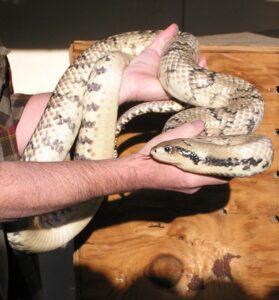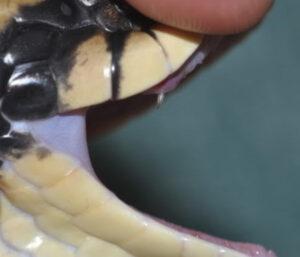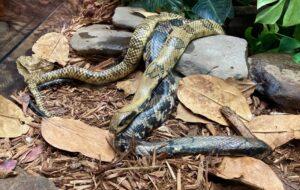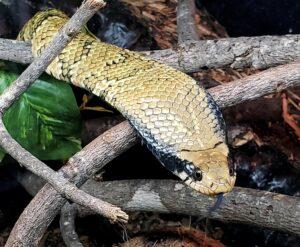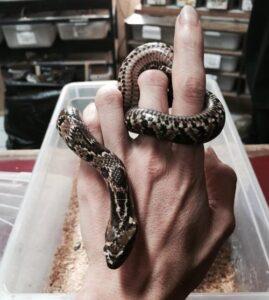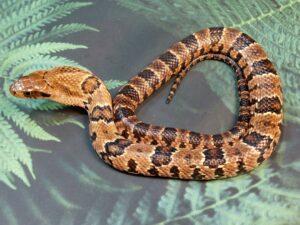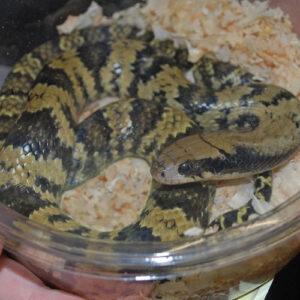
The false water cobra is a snake of the Colubridae family that owes its name to its forming of a hood, just like a real cobra, when threatened. But unlike a cobra, it holds its head up horizontally and not vertically. The ‘gigas’ in its scientific name is the Latin word for ‘giant’, as these snakes are massive in length.
Scientific Classifications
- Suborder:Serpentes
- Family:Colubridae
- Genus:Hydrodynastes
- Species:H. gigas
Conservation Status
Subspecies and Morphs
There are no recognized subspecies of this snake. But as it is a good pet, breeders have come up with its morphs. The most common ones are,
- Hypo
- Lavender
Description
Size
Most full-grown false water cobras reach a total length of 6-8 ft (2m). Some may even exceed 10 feet (3 m). Having a medium body that is neither slender nor heavy, they have an average weight of around 3.5 pounds, exceeding 4.4 pounds for mature adults and going up to 10 pounds in some cases.
Color and Appearance
The background color of a mature false water cobra is olive green or brown with occasional splashes of yellow, dark brown, and black. Typically, black bands or large dark squares run down the entire length of its body. The color helps camouflage the snake in its natural habitat. Its large eyes and circular pupils allow good vision during the day. The forked tongue is black in color.
Are They Dangerous to Humans
This species lacks a traditional, large venom gland. However, secretions from the Duvernoy’s gland, separate from the salivary gland, are mildly toxic and not fatal. So, the snake’s bite isn’t venomous but can be extremely painful as it bites aggressively with a slashing motion, to wound its enemy. Long chewing bites could lead to painful swellings and even bruising. But the snake can’t kill you which is why to date, no deaths have been attributed to its bite.
As pets, they are usually even-tempered, exhibit high levels of intelligence, are easily socializable, and can grow very trusting. But their temperaments can vary a lot – some are very docile and averse to biting, while others are quite aggressive and even intimidating. They do well with semi-frequent handling. When agitated, the snake whips its tail around quite violently and shouldn’t be mistaken to be in a good mood.
False Water Cobras at a Glance
Distribution
In South America, the snake is found from eastern Bolivia to southern Brazil and also in Argentina and Paraguay.
Habitat
It lives in wet, humid regions and marshlands, typically in areas with tropical rainforests. Though it has also been found in dryer areas, it is not the habitat it prefers. In fact, its affinity towards wetlands has earned it the name false ‘water’ cobra.
Predators
It has very few natural enemies and is itself a predator in its habitat.
Reproduction
Oviparous (females lay eggs that hatch outside their bodies)
Male false water cobras are sexually active all round the year, while the females like to mate seasonally or annually. Larger females are likely to give birth to more babies. Being prolific breeders, they regularly produce two egg clutches every year. Each clutch size has an average of 12-24 eggs. However, clutches with as many as 36 eggs are not rare. Eggs hatch typically after 6 days of being laid at an incubation temperature of 83°F (28°C).
Hatchlings measure 38 cm (15 inches) in length and resemble garter snakes. They are much darker in color but don’t have the dark eyes of the adults.
Temperature: 85°F during the day and 78°F during the night is ideal.Though the species doesn’t bask, you can provide a hot spot of 90-95°F for several hours daily.
Humidity: 50% – 60%. Since it thrives in wetlands, it makes sense to include a big water basin in its tank where it can soak its body completely.
Substrate: Absorbing substrates like cypress mulch or orchid bark are ideal as it regulates the humidity by holding on to water. It also keeps the enclosure clean as the snake is notoriously messy.
Source
reptilesncritters.com, ball-pythons.net, 64.media.tumblr.com, a-z-animals.com, scontent.fccu4-2.fna.fbcdn.net, reddit.com, static.wixstatic.com

